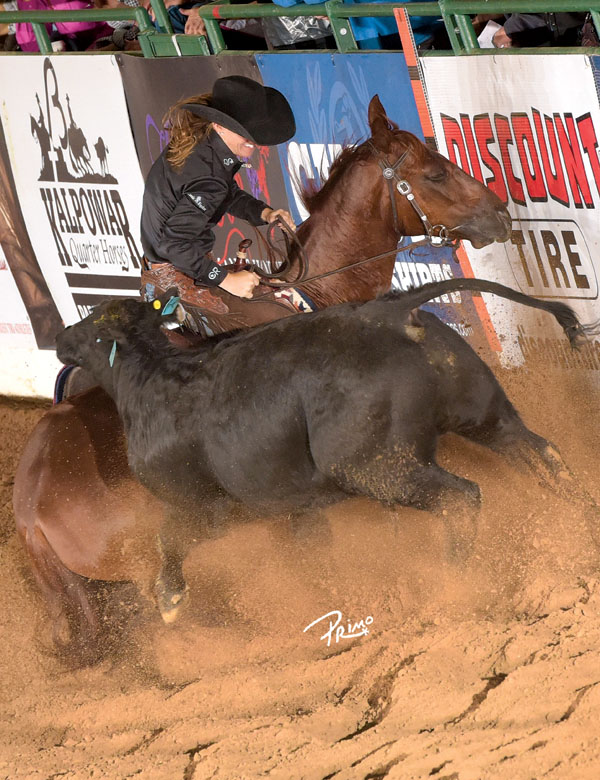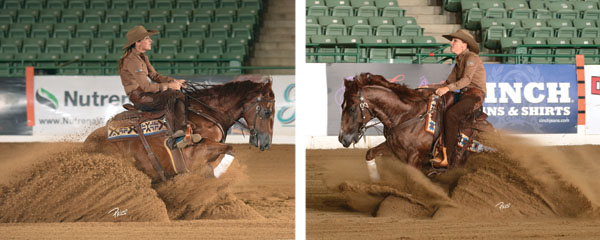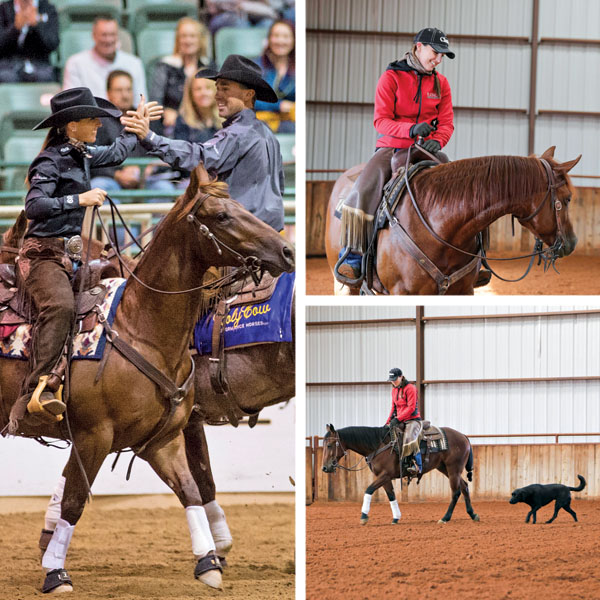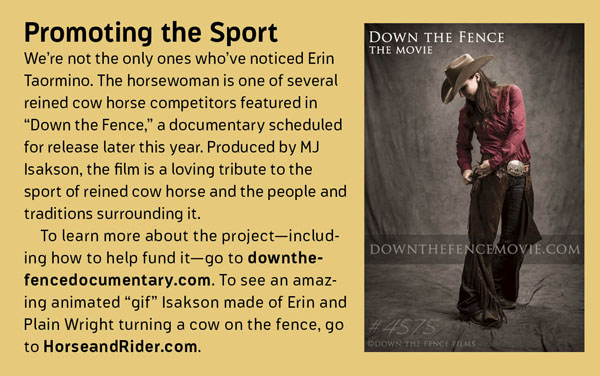“Oh, ladies! Oh, boys, boys! Erin Taormino is in the house!”

Announcer Darren Moore was gleeful as he prepared to reveal the score of the most sensational fence work at last October’s Snaffle Bit Futurity in Reno, Nevada. With rising incredulity, he intoned: “How about…two…twenty…eight!”
That score, almost unprecedented in the 45-year history of the event, propelled Taormino to the reserve championship in the open division. And this wasn’t just any contest; this was the National Reined Cow Horse Association’s premier event—arguably the world’s toughest challenge for 3-year-old performance horses.
With a flourish and a smile, the Ashland, Kansas, trainer became only the second woman ever to finish in the top two spots in the SBF open. She was knocking hard at the door that, so far, only Sandy Collier has passed through (by winning the open championship in 1993).
Remarkably, this was only the fourth trip to the event for the 33-year-old Taormino—and only the second time she’d made the open finals.
Accomplishment of this sort gets our attention. Plus it makes us wonder…how did she do it?
We decided to find out.
She Came to Win
Focus and determination anchor this young trainer’s formula. Check her personal and professional Facebook pages, and you’ll find a stream of motivational articles and videos, stuff with titles like, “Quitting Is Not an Option” and “I’m Not Afraid to Die on a Treadmill.”

Erin is a fan of such inspiration, “especially over the last couple of years,” she says. So much so, in fact, she had her husband write her motto on the inside of her forearm in gold Sharpie every day at Reno.
That motto? “I can and I will.”
Erin explains: “One of the videos I watch repeats the phrase ‘I can, I can, I can.’ I liked it, and I started thinking, ‘I can and I will.’” Before long, her #icanandiwill hashtag was flowing to Facebook pages through her Instagram account, and her Sharpie-marked arm was turning heads in the warm-up pen.
Part of her confidence at Reno came from the excellent horses she was riding, including her winningest mount, Plain Wright. Bred and owned by Gardiner Quarter Horses (where the Taorminos are resident trainers), the gelding is by Hes Wright On and out of Isabellena, with Smart Little Lena, Reminic, and Peppy San Badger in his extended pedigree.
The gelding competed in the intermediate division of the futurity as well as the open. Each division has its own start-over finals, and the preliminaries as well as all finals consist of three separate parts—work in a herd, on a reining pattern, and with a single cow down the fence.

This means that by the time of his open-finals fence run, Plain Wright was stepping into the ring to perform for his ninth time over a two-week period. Plus, the run just before his and Erin’s was that of the eventual champions: million-dollar-rider Jake Telford of Caldwell, Idaho, and the mare Starlight Kisses, bred and owned by Holy Cow Performance Horses of Santa Ynez, California.
“I was sitting down in the tunnel, my horse was tired, and I could hear the crowd going crazy for Jake’s run,” Erin recalls. Telford’s score, an impressive 221, catapulted him into the lead for the championship. Erin was happy for him—“because you want everyone to do well in the finals”—but she also didn’t want to follow that crowd-pleasing run with a disappointing go.
“It was nerve-wracking,” she admits. “To stay focused, I told myself, ‘You have a great fence horse, so just do what you know how to do—not anything fancy or crazy.’”
Telford and Erin high-fived as they passed in the arena—he on the way out, she on the way in. “Right after that I had this amazing moment of just feeling blessed to be there,” says Erin. “And I thought, ‘Let’s go do it.’”
‘Seeing’ Is Believing
Erin had visualized the ideal fence run in advance—quick and clean, with two neat turns of the cow down the fence, followed by a businesslike circling-up.

“I imagined what it would look like, how it would feel. And, incredibly, it happened just that way. The most natural thing is to think about what could go wrong, to dwell on the negative. I’ve tried to train myself the opposite—to kick out the negative with the positive. If I’m mentally in the right frame of mind, anything is possible.”
She also says it’s less draining to be positive than negative, and her expression going down the fence confirms this. “I swear I’m not smiling intentionally!” she says with a laugh. “I think I’m straining…but, then again, it darn sure is fun.”
And how did she manage to get such a great run out of her horse after a grueling week of competition? Using savvy horsemanship.
“For the intermediate finals, I didn’t school him as much as I did for the preliminaries—just touched on a few things that’d make a difference. For the open finals, I did hardly anything—just loped some circles to stretch his legs, and brushed up a few things. I mostly left him alone to make sure I’d have enough horse.”
Her strategy worked, and the score from that run, a 228, is a breathtaking outlier (see “Two-Twenty-What?,” page 68). It bumped Erin and Plain Wright up to a composite score of 655.5, which matched that of Telford and Starlight Kisses. Because NRCHA rules say ties are to be broken with the higher fence-work score, it looked for many moments as if Erin’s ideal run had carried the day. But then a correction to Telford’s total after the arena drag put him a half point ahead.
Not many human beings, no matter how enlightened or disciplined, could remain positive under such a crushing disappointment. But Erin did.
“I’m a firm believer that everyone makes mistakes,” she explains. “One of the scribes just added it up wrong. It wasn’t an adjusted score, but a corrected one.
“I’m happy for Jake,” she goes on. “He’s been at this a whole lot longer than I have, plus I never fathomed I could be even a reserve champion this soon. Or be in the company of the three other women who’ve made it into the top three in the open—Sandy Collier, Annie Reynolds, Dema Paul. I’m not disappointed at all!”
Talk about attitude. As it says on her Facebook page, “A great attitude becomes a great mood, which becomes a great day, which becomes a great year, which becomes a great life.”
Not to mention a great futurity. In addition to winning the open reserve championship, Erin finished top-10 in the intermediate division and won the ladies championship on Plain Wright. On the stallion Bet On Boon, owned by Dorothy Queen of Whitesboro, Texas, she nailed another top-10 in the intermediate.
Not bad for a relative newbie.
Will Work for Success
But hold on. Yes, Erin is relatively new to SBF competition. Still, she’s been working hard at learning and “paying dues” her whole life. Her childhood on a farm in Southern Saskatchewan, Canada, included a first pony that challenged her, plus 4-H participation on a young Quarter Horse gelding that helped her believe she might someday become a trainer.

An early mentor was Tom King of the Diamond K Ranch, “one of the best horsemen I’ve met.” Jess Hartung of Alberta, her youth coach after high school, helped her with all-around competition, and Erin competed successfully at the All American Quarter Horse Congress.
At 19, determined to follow her dreams, she moved to Texas. That was in 2001; she loped cutting horses for a while, then fell in love with reined cow horses while working for NRCHA Hall of Famer Ron Ralls, for four and a half years. During this time she also met her husband-to-be, Anthony Taormino, who starts 2-year-olds; they married in 2006.
At the end of 2008 the couple moved to Oregon to work for Todd Bergen, the two-time SBF open champion who’s won more than $4 million in reining, reined cow horse, and cutting competition. Under his tutelage, Erin competed in her first Snaffle Bit Futurity, in 2011.
“I learned so much from Todd,” she says, “not just about what to do in the arena, but also about how to run a business.”
In January of 2014, the Taorminos went out on their own, becoming the trainers at Gardiner Quarter Horses in Ashland, Kansas. That same year, she made the open and intermediate finals for the first time at the Snaffle Bit Futurity, and the next year she had her most successful futurity showing to date.
Still a Struggle
These successes have boosted her confidence and helped her overcome the feeling that prior placings were flukes.
“I don’t think the struggle for confidence ever goes completely away, for any of us,” she says thoughtfully. “But it’s how you handle that struggle, how you choose to approach the difficult times, that matters.”
This may be why her real-life hero is the mixed martial artist phenomenon Ronda Rousey.
“A lot of people don’t like her, but I’ve read a lot about her. She recently got dethroned, and what she said about that makes me respect her even more. She’s human, she’s vulnerable, but she said it’s how you work through it and come back after getting beat that matters. Mental strength is her thing, yet she’s not even afraid to cry and be a girl and share her deepest feelings in an industry that’s more commonly for men.”
Erin sometimes finds it hard to temper her own intensity.
“It’s been tough for me just to let go and allow my horses to do their jobs, trusting that they’re broke and where they need to be. But I know it’s all about learning from mistakes. Having multiple horses to go show has really helped, and the Gardiners have been great about that,” she says.
She repays the favor by working incredibly hard.
“It gets warm here in the summertime,” she says of the Gardiners’ Kansas ranch. “So to save the horses and cattle and ourselves, Anthony and I start at 1 or 2 in the morning and try to get everything worked before it gets hot. In winter, we start around 7 a.m. and keep going until we’re finished.”
In fact, she says, it’s ultimately hard work that “gets you where you want to be.” Asked her advice for those just starting out, she didn’t hesitate.
“If you can, go and work for whoever you idolize. Put your head down and do the best possible job for them you can. It’s all about proving you deserve to be there, not that anyone owes you anything. This isn’t an easy industry to make it in, but if you work hard and keep a positive outlook, then…you can and you will.”






